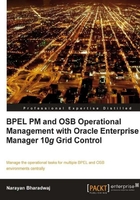
A management solution needs to locate and identify whatever it needs to manage. This process is called discovery, where the management solution locates and identifies all the targets. This is typically done using management agents that are deployed on servers that contain the targets that need to be managed. Discovery of targets enables administrators to have a picture of the environment along with the various components that need to be managed.
For any small, medium, or large enterprise, the challenge is to manage several disparate targets from a single console. The traditional hardware and software components such as servers, storage devices, operating systems, databases, middleware, and applications have been managed by system management solutions. However, a new breed of BPEL-based applications and infrastructure poses new problems. First, they need to be managed along with existing hardware and software. Second, as the BPEL projects proliferate across the enterprise, the infrastructure team is faced with increasing problems to manage these projects. Third, for the administrators who are new to BPEL, supporting these environments in production poses unknown challenges. Finally, the IT managers want to avoid hiring new administrators with increasing BPEL projects.
Grid Control provides a way to discover the BPEL components, whether it's on production or otherwise. For the infrastructure team, this is a convenient way to manage several installations from one console. Once the agent is installed on each of the servers hosting BPEL PM, the discovery process can be initiated from the console.
In this chapter, we will discuss how to discover and configure a BPEL Process Manager target. Discovery of BPEL PM targets is the first step before performing other management tasks. Further, creating the infrastructure service is mandatory to manage BPEL processes and related infrastructure. The following areas are covered in this chapter:
- Support for managing BPEL PM
- BPEL PM target discovery
- Navigating to application servers
- Discovering a BPEL PM target
- Navigating to the BPEL PM target home page
- Configuring a BPEL PM target
The BPEL PM product ships with a console that is useful for administration activities such as turning a process on or off, deleting instances, checking the flow of an instance, and so on. However, it cannot provide management capabilities such as monitoring the availability and health of the servers, processes, configuration management, and bulk deployment.
Grid Control introduced BPEL management functionality with the 10.2.0.3 (or 10gR3) version, released in January 2007. The first release provided most of the functionality for monitoring the BPEL infrastructure including the BPEL PM server. Additionally, it had process-level monitoring, error-instance management, and service-level management.
The 10.2.0.4 (10gR4) version, released on Linux platforms in November 2007, brought additional new features for managing BPEL PM. Configuration management, deployment automation, and adapter monitoring were the main features of the release. The 10.2.0.5 (10gR5) version, released on Linux platforms in February 2009, added reporting capabilities for tracking troublesome BPEL instances.